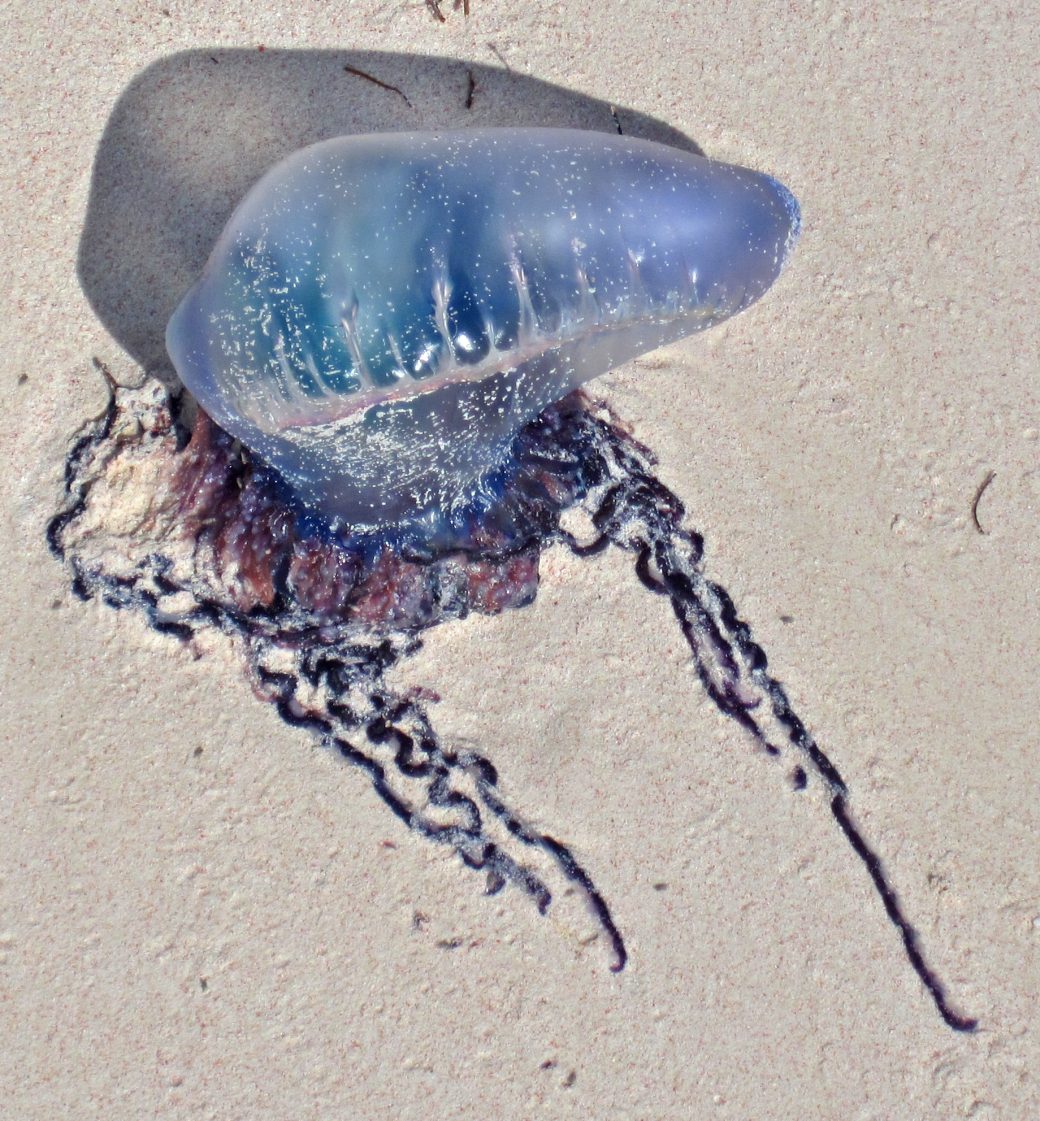
by DGR News Service | Sep 14, 2020 | Biodiversity & Habitat Destruction, Human Supremacy, NEWS, The Problem: Civilization
Our use of plastics has threatened oceans and the marine biodiversity. But our efforts for plastic cleanup, may well threaten a less-known marine ecosystem. This article was originally published in DW.com
Little is known about the neuston, but marine biologists fear this community of organisms living on the ocean surface could be decimated as nets sweep up plastic pollution.
In May 2017, shells started washing up along the Ligurian coast in Italy. They were small and purple and belonged to a snail called Janthina pallida that is rarely seen on land. But the snails kept coming — so many that entire stretches of the beach turned pastel.
An unusual wind pattern had beached the animals. And for the people who walked the shore, this offered a rare encounter with a wondrous ecosystem that most of us have never heard about: The neuston.
The neuston, from the Greek word for swimming, refers to a group of animals, plants and microorganisms that spend all or large parts of their life floating in the top few centimeters of the ocean.
It’s a mysterious world that even experts still know little about. But recently, it has been the source of tensions between a project trying to clean up the sea by skimming plastic trash off its surface, and marine biologists who say this could destroy the neuston.
A world between worlds
The neuston comprises a multitude of weird and wonderful creatures. Many, like the Portuguese man-of-war, which paralyzes its prey with venomous tentacles up to 30 meters long, are colored an electric shade of blue, possibly to protect themselves against the sun’s UV rays, or as camouflages against predators.
There are also by-the-wind sailors, flattish creatures that raise chitin shields from the water like sails; slugs known as sea dragons that cling to the water’s surface from below with webbed appendages; barnacles that build bubble rafts as big as dinner plates; and the world’s only marine insects, a relation of the pond skater.
Between the Worlds
They live “between the worlds” of the sea and sky, as Federico Betti, a marine biologist at the University of Genoa, puts it. From below, predators lurk. From above, the sun burns. Winds and waves toss them about. Depending on the weather, their environment may be warm or cool, salty or less so.
But now, they face another — manmade — threat from nets designed to catch trash. A project called The Ocean Cleanup, run by Dutch inventor Boyan Slat, has raised millions of dollars in donations and sponsorship to deploy long barriers with nets that will drift across the ocean in open loops to sweep up floating garbage.
Plastic and marine life are moved by currents
“Plastic could outweigh fish in the oceans by 2050. To us, that future is unacceptable,” The Ocean Cleanup declares on its website. But Rebecca Helm, a marine biologist at the University of North Carolina Asheville, and one of the few scientists to study this ecosystem, fears that The Ocean Cleanup’s proposal to remove 90% of the plastic trash from the water could also virtually wipe out the neuston.
One focus of Helm’s studies is where these organisms congregate. “There are places that are very, very concentrated and areas of little concentration, and we’re trying to figure out why,” says Helm. One factor is that the neuston floats with ocean currents, and Helm worries that it might collect in the exact same spots as marine plastic pollution. “Our initial data show that regions with high concentrations of plastic are also regions with high concentrations of life.”
The Ocean Cleanup says Helm’s concerns are based on “misguided assumptions.”
“It’s true that neustonic organisms will be trapped in the barriers,” says Gerhard Herndl, professor of Aquatic Biology at the University of Vienna and one of project’s scientific advisors. “But these organisms have dangerous lives. They’re adapted to high losses because they get washed ashore in storms and they have high reproductive rates. If they didn’t, they’d already be extinct.”
Helm says they just don’t know how quickly these creatures reproduce, and in any case recovering from passing storm is very different from surviving The Ocean Clean Up’s systems which could be in place for years.
Still a lot to learn about the neuston
In December, The Ocean Cleanup and Helm participated in a symposium on the topic hosted by the Institute for Risk and Uncertainty at the University of Liverpool in the UK. Since then, direct communication between them has stopped, says Helm. “They’re not interested in talking to me anymore.”
Both sides agree that much is still unknown about the neuston. But one thing that has been established is that most of the oceans’ fish spend part of their lifecycle in the neuston. “More than 90% of marine fish species produce floating eggs that persist on the surface until hatching,” Betti says.
The Ocean Cleanup has undertaken one of the few studies into this ecosystem, collecting data on the neuston on the relative abundance of neuston and floating plastic debris in the eastern North Pacific Ocean during a 2019 expedition to the Pacific Garbage Patch, an area where plastic pollution has accumulated on a vast scale. But it is not yet sharing what it has found. The information was being prepared for publication in an as of yet unspecified journal, probably some time next year, an Ocean Cleanup spokesperson said.
Is the solution inshore?
Helm believes the best way to tackle the marine plastic problem would be to position the barriers closer to land — across river mouths and bays — to catch garbage before it reaches the sea.
“Stopping the flow of plastic into the ocean is the most cost-effective — and literally effective — way to ensure that it’s not entering our environment,” she says. As for the plastic already floating in open waters, she does not believe it is worth sacrificing parts of neuston and wants to see more research first.
The Ocean Cleanup has made barriers across rivers a part of its mission. But it is also going ahead with its original vision of pulling trash from the open water. In late 2018, the project deployed a 600-meter, u-shaped prototype net into the Great Pacific Garbage Patch.
The system ran into difficulties, failing to retain plastic as hoped, and needing to be brought shore for repairs and a design upgrade, after which Ocean Cleanup says it gathered haul of plastic that it will recycle and resell to help fund future operations. Over the next two years, the project hopes to deploy up to 60 such barriers to collect drifting flotsam. Helm isn’t the only one concerned about these plans.
“We should think twice about every action we take in the sea,” Betti says. “In nature, nothing is as easy as we think, and often, we’ve done a lot of damage while trying to do a good thing.”
This article was first published on www.dw.com. You can find the full and original article here:
https://www.dw.com/en/environment-conservation-plastic-oceans/a-54436603
Featured Image: A Portuguese man-of-war by Wikimedia Commons via Creative Commons 2.0
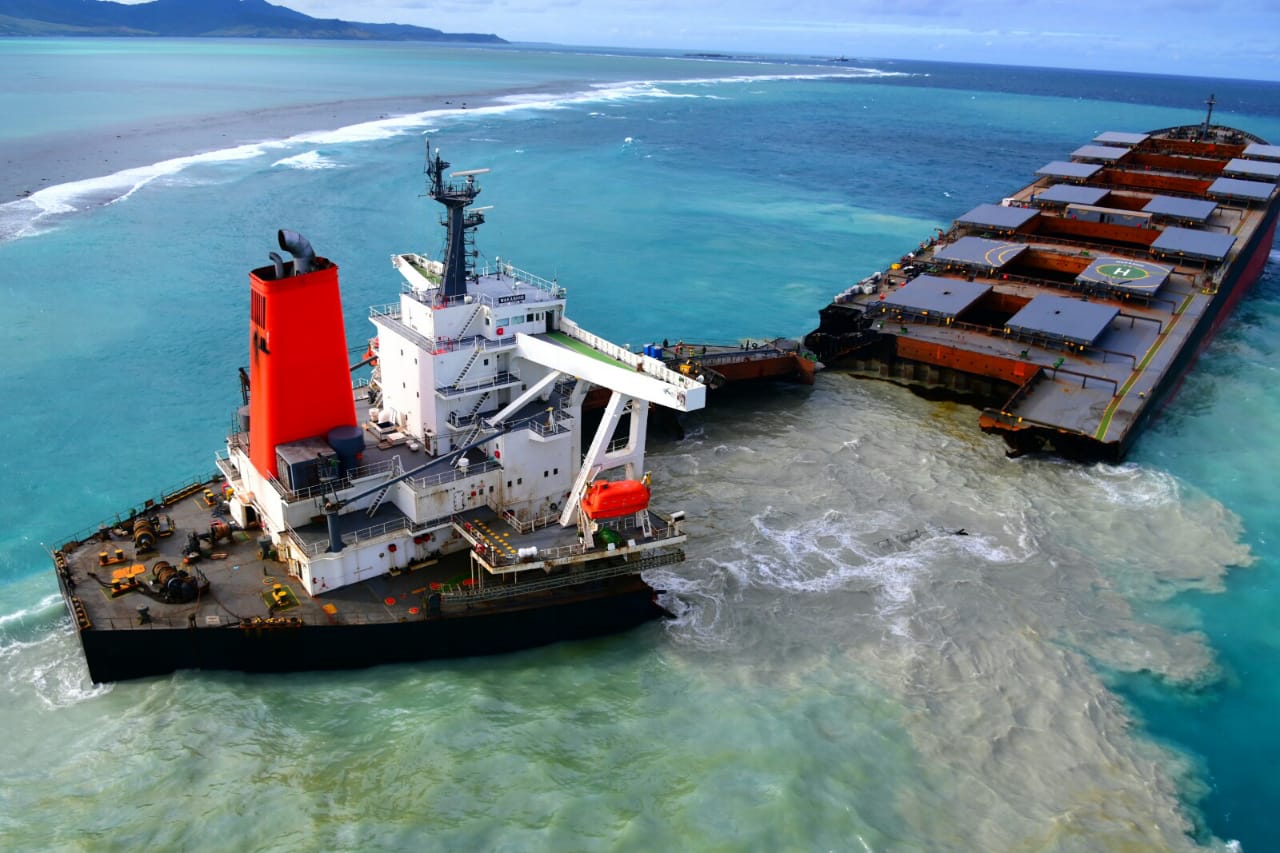
by DGR News Service | Sep 11, 2020 | Biodiversity & Habitat Destruction
This article was written by Malavika Vyawahare on 1 September 2020 and originally published on Mongabay.
- People gathered in the thousands in Mauritius’s capital, Port Louis, to protest the government’s response to a recent oil spill.
- The Japanese-owned freighter M.V. Wakashio crashed into the coral reef barrier off the island’s southeastern coast on July 25 and leaked about 1,000 tons of fuel oil into the sea near ecologically sensitive areas, before breaking in half a few weeks later.
- The stranding of at least 39 dolphins and whales near the site has sparked an outcry, though a link between the Wakashio shipwreck and the beachings has not yet been established.
- In a controversial move, the Mauritian government decided to sink the front half of the ship several kilometers away from the crash site in open waters, which some experts say could have impacted the dolphin and whale populations.
Thousands of people demonstrated in Mauritius on Aug. 29 over the government’s handling of a recent ship grounding that spilled 1,000 tons oil in the seas around the island nation. In what appears to be the latest toll in the incident, dolphins and whales have beached close to where the M.V. Wakashio freighter ran aground and broke up. Thirty-nine of the mammals have beached in the week to Aug. 28. Social media is awash with photos of the stranded animals, including mothers and calves.
At a press conference Sudheer Maudhoo, the Mauritian fisheries, marine resources and shipping minister, called the beachings a “sad coincidence.” Though a link between the deaths and oil contamination has yet to be established, disaffection has swelled in the aftermath of the spill, with protesters taking to the streets of the capital, Port Louis, and wielding an inflatable dolphin with “Inaction” written on it.
The Wakashio struck the coral reef barrier off the country’s southeastern coast on July 25; the damage to its fuel tankers led to a leak on Aug. 6. The fact that the ship lay lodged in the coral reef for more than 10 days before any decisive action by the government has become a sour point for Mauritians demanding answers from the authorities.
“The oil spill became like a culmination of growing frustration in the country. Since we have this new government, there were a series of issues and the Wakashio oil spill was the last straw,” said Mokshanand Sunil Dowarkasing, a former member of parliament who now works with Greenpeace in Mauritius. The vessel lay stranded in the vicinity of at least three sites of ecological significance: Blue Bay Marine Area; Pointe d’Esny, the largest remaining wetland in Mauritius; and the coral isle of Ile aux Aigrettes, which is a nature reserve. Facing mounting pressure from abroad and within the country, the government hastened efforts to pump out the oil that remained on board, even as a ship was at the brink of breaking apart. On Aug. 15, it broke into two, but by then most of the oil on board had been removed. The situation, however, has only grown murkier since.
This article was written by Malavika Vyawahare on 1 September 2020 and originally published on Mongabay. The original article can be accessed here:
https://news.mongabay.com/2020/09/mauritians-take-to-the-street-over-oil-spill-and-dolphin-and-whale-deaths/
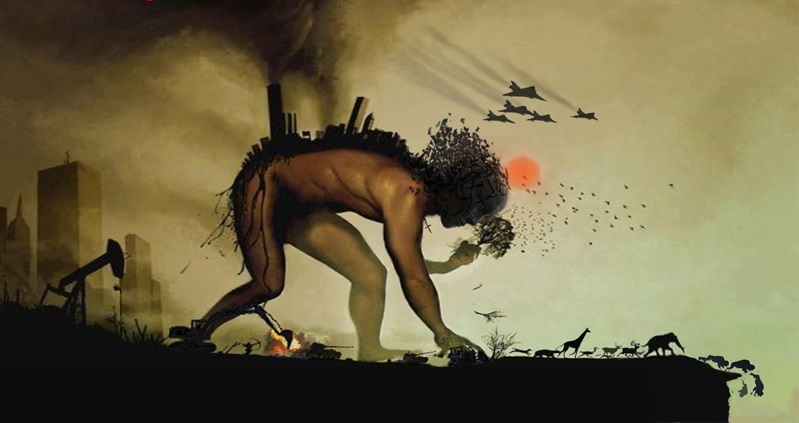
by DGR News Service | Sep 8, 2020 | Human Supremacy, The Problem: Civilization
Ross Carter offers a critical review of Naomi Klein’s Shock Doctrine. He arguably enriches Naomi’s own assessment of the situation by adding a DGR analysis.
By Ross Carter
Using crisis as an opportunity to get rich
In her book, the Shock Doctrine, Naomi Klein details a particular trope of modern capitalism. That of using and/or creating shock and disaster to advance its agenda. Like the majority of liberal literature this book left me with more questions than answers. For example, is it just capitalism that uses crises to advance? Was life amazing before neo-liberal capitalism came along? Are discussions about different shades of civilization a waste of time? Is this whole book a distraction? Although frustrating at times and limited in its perspective, the history mapped out in this book did still have a lot to offer and to ponder.
The Traumatised Traumatise
One thing I take home from this book is how modern Capitalism is civilization attempting to continue to function and sustain itself, while everything (eco-systems and social structures) collapse around it. Due to Naomi’s blind commitment to Democracy and liberalism this would not be a take home though without a mild awareness of the history of civilization, particularly how it has always depended upon war, colonisation, control of populaces (social structure, slavery, police, media, religion and law etc.), and environmental and technological expansion, to sustain a hold over humanity and the planet. Civilization has also always fed off of disaster. This can be clearly seen in the fact that although individual civilizations collapse, disasters in themselves, civilization itself has continued to spread across the planet eating up wildlife, including wild humans, in its path.
The story that Naomi tells is not an isolated story, it is one that has been going on in one form or another for as long as civilization has existed. The logic of Civilization is to protect itself at any cost, and that logic continues unabated. Without a deeper analysis you are stuck in the limited perspective that if only we could get rid of those horrible capitalists then everything would be ok. This is a naive over-simplification of the issues we face. It ignores the current and rapid murder of the planet by Industrial civilization.
It ignores the reality of the lives of passive desperation, the mental trauma, anguish and grief that humanity, as a whole, currently lives with.
Another lesson or reminder I took away from reading the book was how war and conflict is integral to civilization and its expansion and survival. All expansion (aka colonisation) has depended on violence and conflict and left destruction in its wake. Civilization in turn traumatises individuals, communities and cultures, then takes advantage of that trauma to grow and expand. This was true in Iraq in 2004 and it was true in Iraq (AKA the Fertile Crescent) in 6-8,000bc when one of the first civilizations is said to have formed/spread their leaving decimation and desert in its wake.
This needs repeating. The land that Iraq now sits on was being pillaged and destroyed by civilization 10,000 or so years ago. The language I am writing in, it is said, evolved out of the Middle Eastern languages of the time. The Shock Doctrine is part of a continuum. We, the civilized, are doing the same things now that civilized peoples were doing 10,000 years ago. Changing from neo-liberal capitalism to a more social capitalism, replacing oil wells with lithium and rare metal mines (for ‘green’ technologies), isn’t going to change anything. The Shock will continue until we do something about the problem at the core, civilization itself. Or until civilization reaches, what seems like an inevitable suicidal endgame. The almost complete end of life on this planet.
“I am not arguing that all forms of market systems are inherently violent” p20.
The Shock process that Naomi defines and recognises is at the core a continuation of colonialism. It is hyper-colonialism. It is a confirmation by those in power that they are in power and that they are willing to do anything to stay in power. It is an extra layer of colonialism. And therefore an extra layer of trauma and destruction. Competition is at the core of all civilized relationships and the civilized psyche itself. It is at the core of agricultural societies who fight each other and wild nature for the space to deforest and grow. It is at the core of modern civilization in all its teachings and all it upholds. Competition we are told is natural and good. We appear to have forgotten what is natural and good. We have seen no other path. We are conquerors and dominators. Takers. We do not know what it is to be human be-ings, only human war-ings. This is apparent in Naomi’s book.
From Chile to Iraq via New Orleans. The only direction we can go is towards increasing levels of control and dominance. Unless we change this mindset we will continue on this path indefinitely. Civilization can wear a facade of democracy or liberalism but it is merely that. A facade. Equality and co-operation are not possible in civilization. They are in direct contradiction to its inbuilt needs to expand and control.
Changing this mindset is an intense and thorough task, but it is the only one that will make a difference long term.
Joe Biden and solar panels are not going to cut it. Just as different leaders and more technology have never made a difference before. Only increased and sped up the expansion and control of civilization. There will be no simple solution or saviour. Our desperation to control and dominate from the White House and board room, to our patriarchal nuclear family, stems from the same place. Mass cultural trauma. As Naomi points out, a broken individual is easy to manipulate and control. And we are all broken by civilization. We are traumatised in the womb. We are traumatised in birth. We are born into generational trauma. We are traumatised within our dysfunctional families and social structures. We are traumatised by our ‘education’. We are traumatised by the boxes we are put in and the masks we have to wear. We are traumatised by pollution, by food, by technologies. Etc. Etc.
The traumatised mind is a warring and competing mind. It is one that cannot be satiated. Civilization commodifies and others us. It turns us into objects and roles. Slave, farmer, chief, wife, husband, etc. THAT is shock and awe. The shock that Naomi defines is an interesting story and one worth hearing, but it is also an addendum, and like all leftist analysis it ignores or denies the rest of the book. It ignores what led to that addendum. If we continue not to see how violence and (our own) trauma and shock are integral to the establishment and sustenance of civilization, not just neo-liberal capitalism, then our solutions and actions, like all leftist/liberal solutions, are going to achieve absolutely zero when facing the bigger picture of the murder and enslavement of the planet and of ALL life on it by civilization.
Our blindness to reality is related to our mass trauma, perpetuated by our education system and media.
The media are masters of shock. Naomi points out how the military targeted certain industries in Iraq to increase the shock to the populace. Just as important was the taking over of the media. Of the stories being told to the Iraqi people. The media pacifies through dumbing populations down, through fear mongering, and simply through lying or covering up the truth, It is quite amusing but also sad to note that Naomi, and all of her other liberal pals, are suffering from the very symptoms she herself defines. That of a forgetting. A cultural amnesia. A reconditioning, brainwashing (let’s call it what it is). Let’s not forget that liberals are traumatised too.
One only needs some basic understanding of the history of civilization to know that at its core since its inception it has depended on slavery (by the whip or by economic/cultural control), genocide, ecocide and colonisation. This is completely ignored though. Why? Why would liberals continue to preach for, and believe in, those very things which are used to oppress them? The Green New Deal and Democracy aren’t going to remove the shock to the system that living hollowed out lives on a hollowed out planet perpetually puts us through. Yet they are worshipped. How could you read this 533 page book, in your break at the office, or sitting in your city apartment, the sound of sirens and cars droning around you, smell of pollution in the air, zero wildlife, about how capitalism uses shock to further its agenda, and not recognise the shock, all around you and within you? The obvious answer is that liberals have been shocked themselves.
We have all been shocked.
Then in this lost, disconnected state we are all susceptible to the easy solutions of religion, gurus, demagogues and techno-fixes. We are all malleable. People do not willingly hand over their personal power and autonomy and that of their community, to civilization, unless they have first been broken as a human and built up again as a citizen. We will only really be able to think clearly and connect to one another and the earth again once we throw off the myths that civilization holds us down with. Once we, as individuals and communities, destroy civilization as a concept and a physical system. For it is only beyond civilization that we can really be free from continued shock and perpetual disaster.
Ross Carter is a sytems thinker, critic and DGR guardian based in the UK.
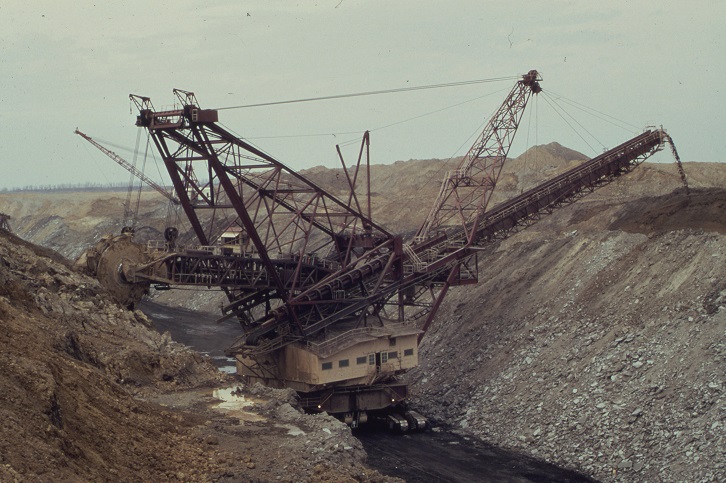
by DGR News Service | Sep 7, 2020 | Human Supremacy, Mining & Drilling, The Problem: Civilization
In this excerpt from the original article, written by Bong S. Sarmiento and published in Mongabay on 30 August 2020, Gong describes how ‘authorities’ have yet to approve plans for a copper mine in the Tampakan are of the Philippines. The mines would affect ancestoral land and the lives of the mountain people.
By Bong S. Sarmiento/Mongabay
Officials Quash Plan, For Now, To Develop Philippines’ Biggest Copper Mine
- The Philippine municipality of Tampakan has canceled an agreement with Sagittarius Mines, Inc. to develop a $5.9 billion copper and gold mine on the island of Mindanao.
- Municipal councilors criticized the “lopsided” nature of the deal that they said had not been periodically reviewed as required and had sold the community short.
- The Tampakan project has faced opposition since mineral reserves were discovered there in the ’90s, with pushback coming from various levels of government, Indigenous communities, the Catholic church, environmentalists, and even communist rebels.
- An Indigenous group that has taken up arms against the project has warned of more bloodshed should the project go ahead on their ancestral lands.
SOUTH COTABATO, Philippines
Officials in the southern Philippines have canceled a $5.9 billion project to exploit Southeast Asia’s largest known undeveloped copper and gold reserves, but have left open the possibility of the venture being revived.
The municipal council of Tampakan, home to 40,000 people in the province of South Cotabato, alleges that Sagittarius Mines, Inc. (SMI) failed to honor its side of the agreement governing the development of the mine. That deal, the municipal principal agreement (MPA), is supposed to be reviewed and updated every four years, but this hasn’t been done since 2009. There were attempts to review the MPA, but the mayor and other municipal representatives were excluded from the negotiations, the council said.
“After scrutiny, there are provisions in the MPA that are considered vague, disadvantageous to inhabitants of Tampakan and unduly tie the hands of the local government unit [LGU] of Tampakan,” the council said in a resolution dated August 10 but made public on August 14. “As such, the LGU cannot sit and fold its arms not to intervene in any action initiated by its people if, indeed, their rights have been violated contrary to some provisions of the agreement.”
The MPA was already a done deal rather than being negotiated with the government, the resolution said.
Municipal legislators say they’re no longer interested in reviewing or updating the 2009 MPA with the company but are open to creating or formulating a new agreement, which means SMI could still pursue the mammoth Tampakan project under a new municipal agreement.
The resolution has been sent to relevant government agencies but SMI has yet to issue a statement as of the time this article was published. Mongabay sought comment from SMI officials but did not receive a response from the mining firm.
‘Lopsided,’ ‘no justice’
If approved, the Tampakan project would be the largest copper mine in the Philippines and among the largest in the world. The site is predicted to yield an average of 375,000 tons of copper and 360,000 ounces of gold in concentrate per year over a 17-year period. In 1995, the Philippine government granted the Tampakan project the contract to explore and develop the area’s mineral deposits through a financial or technical assistance agreement (FTAA).
The MPA took effect in 1997, and since then SMI has paid Tampakan municipality at least 40 million pesos ($822,370 at current rates), or an average of 2.5 million pesos ($51,400) a year as part of its financial commitments, according to a 2013 state audit. But the terms of the deal are “lopsided,” the council noted in its recent decision.
Days before the council published its resolution, Tampakan Mayor Leonard Escobillo criticized the rental rate that SMI was set to pay for the ancestral lands of the Blaan, the ethnic tribal group whose mountain home will be affected by the project.
Featured image: Creative Commons
This article was originally published in Mongabay on the 30 AUGUST 2020, you can find the full and original article here:
https://news.mongabay.com/2020/08/officials-quash-plan-for-now-to-develop-philippines-biggest-copper-mine/

by DGR News Service | Sep 4, 2020 | Biodiversity & Habitat Destruction
This piece was originally published in Earth Island Journal.
Zambia and Zimbabwe plan to move ahead with the $4 billion Batoka Gorge Dam that would displace villagers, wildlife, and a vibrant rafting industry along the Zambezi River.
by Rebecca Wilbear/Earth Island Journal
More than 50 men traverse the steep, rocky gorge. They balance as many as three kayaks on their back each, along with other equipment for rafting companies offering trips in the Batoka Gorge. Sweat glistens on their skin; they earn a dollar for each kayak. These porters come from the Indigenous Tokaleya villages situated along the edge of the gorge, on either side of the Zambia-Zimbabwe border. For the Tokaleya, the Zambezi River is an essential and sacred deity. It’s also a source of income. Tens of thousands of tourists raft the Zambezi’s rapids each year, drawn to the region’s rich ecosystem. Alongside the Tokeleya, birds, fish, and other wildlife make their home in the gorge.
Yet the section of the river that runs through Batoka Gorge is threatened. In June 2019, the General Electric Company of the United States and the Power Construction Corporation of China signed a deal with the Zambian and Zimbabwean governments to build and finance the Batoka Gorge Dam. The danger from a massive hydroelectric project, which was first proposed nearly 70 years ago, has become urgent.
Africa’s fourth largest river, the Zambezi flows through six countries. The Batoka Gorge section begins at the bottom of Victoria Falls, the largest waterfall in the world, also called Mosi-oa-Tunya, or “The Smoke That Thunders.” A few miles from Livingstone, Zambia, massive roaring waters spill from the sky and turn clear green as the river races through steep, dark canyon walls down the 50-mile gorge. The river then meanders for another 200 miles until it reaches Lake Kariba, the world’s largest reservoir by volume and an example of what Batoka Gorge could become.
I am a river guide, and in October 2019, I embarked on a four-day trip down Batoka Gorge as part of a two-week river guide training. Most of our guides, Melvin Ndelelwa, James Linyando, and Emmanuel Ngenda, were from the Tokaleya villages. Ndelelwa, who was a porter before becoming a river guide, pulled out a picture of a fish he caught at a hidden pool below the falls. It was almost as big as he is. His father was a porter his whole life. Becoming a raft guide in Zambia is hard work. The possibility of learning to guide energizes the porters.
Ndelelwa explains how his younger brother carves ebony root to make Nyami Nyami necklaces. The Nyami Nyami is a mythic river god, a serpent with the head of a fish. Legend has it, this god is angry that his sweetheart is trapped downstream behind the giant Kariba Dam. In 1956, a year into construction, the Nyami Nyami flooded the river, wreaking havoc on the construction site. The odds of another flood in 1957 were a thousand to one. Yet the river rose three meters higher than before, destroying the bridge, cofferdam, and parts of the main wall.
The guides told us that the Nyami Nyami would protect us when we wear the necklace that honors his sweetheart. On the river, I touched mine often, praying for safe passage. I am terrified of big water and scared of flipping. The Zambezi is a huge volume river with little exposed rock. It is extremely challenging, with long and powerful rapids, steep gradients, and big drops. Flipping is common. In high-pressure areas, you can’t even depend on your life jacket to keep your head above water.
On the river, I clung to the raft in awe and terror at the size of the waves. October is the dry season, when the water is low. In December, the rains raise the river and turn it muddy brown. Linyando navigated ahead in a safety kayak while Ngenda captained our raft. At one point between rapids, he pointed out the camouflaged crocodiles sun-bathing on rocks.
Halfway through the training, I was invited to guide the most challenging rapid, Gulliver’s Travels. I had already guided the rapid just prior called Devil’s Toilet Bowl twice, but my angle was off on this third attempt. The raft flipped backwards. I went deep underwater. It was dark and silent. A shaft of light appeared. Then more light. I surfaced. We turned the boat upright, but my confidence was shaken. I thought of backing out of Gulliver’s Travels, until the guides encouraged me. Back in the boat, I sent the raft through.
Throughout the trip, I felt that the guides protected me. Ndelelwa offered his sandal for the steep hike out after I lost my shoe. “This is my home,” he said. “It’s easy for me to walk barefoot.” Later, when I encountered a puff adder — a venomous snake with a bite that can be deadly — near my sleeping bag, Ngenda helped me move closer to the fire. “We sleep here,” he said. “The snakes don’t like fire.” It smolders all night smoking fish for breakfast, a staple food in villages along the gorge.
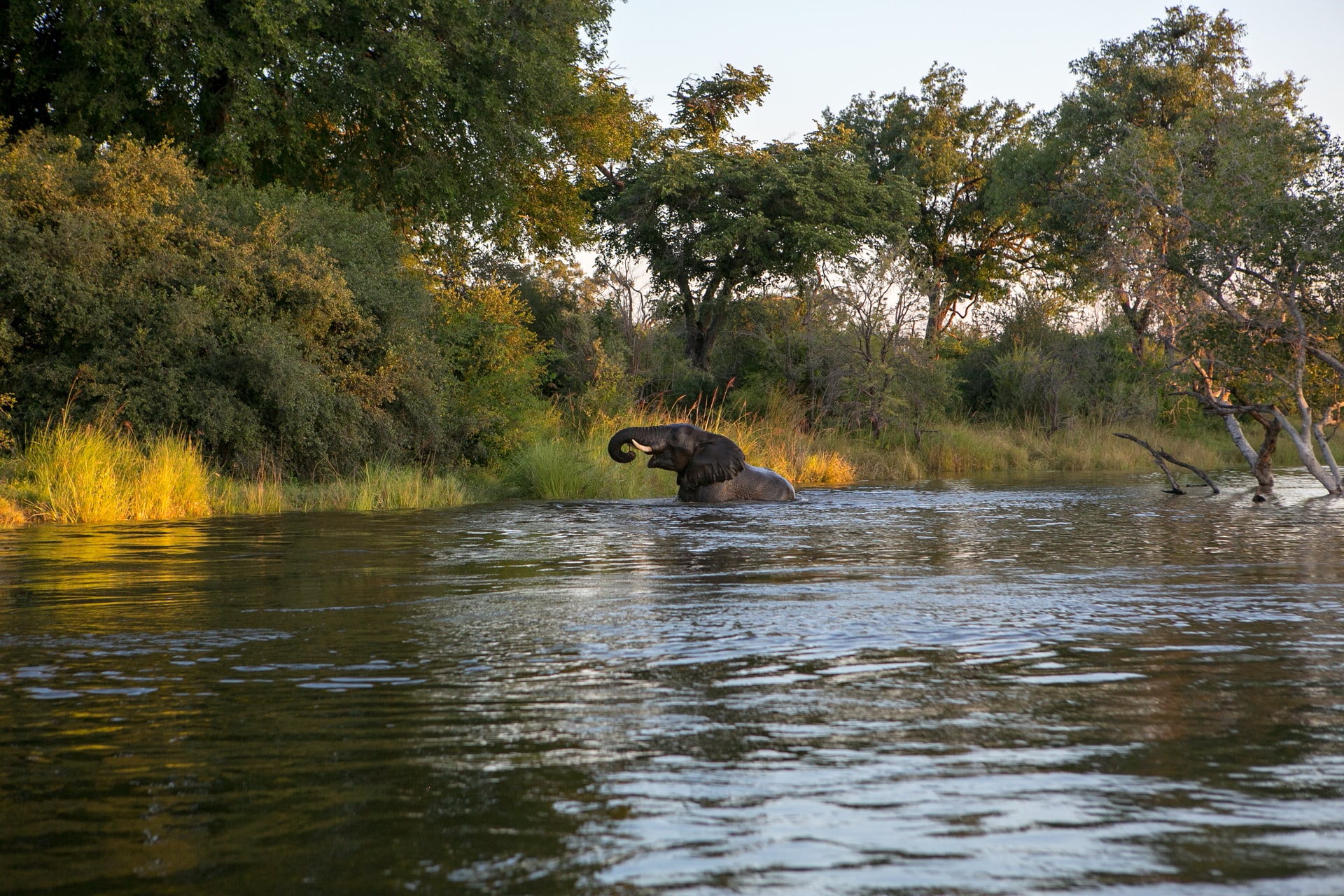 IN 2015, THE WORLD BANK funded an Environmental and Social Impact Assessment (ESIA) that concluded that the dam is a “cheap” solution to the “electricity deficit” of Zambia and Zimbabwe. An airport and road have already been constructed. The reservoir of the 550-foot tall mega-dam will be 16 square miles and a half-mile from the put-in just below Victoria Falls, impacting a UNESCO World Heritage Site sacred to the Tokaleya peoples. The entire canyon will be drowned and destroyed.
IN 2015, THE WORLD BANK funded an Environmental and Social Impact Assessment (ESIA) that concluded that the dam is a “cheap” solution to the “electricity deficit” of Zambia and Zimbabwe. An airport and road have already been constructed. The reservoir of the 550-foot tall mega-dam will be 16 square miles and a half-mile from the put-in just below Victoria Falls, impacting a UNESCO World Heritage Site sacred to the Tokaleya peoples. The entire canyon will be drowned and destroyed.
If the dam build goes ahead, wildlife who live and breed in the gorge will be lost or displaced. The Cornish jack and bottlenose fish need fast-moving water to survive. The extremely rare Taita falcon is endemic to Batoka Gorge — it nests and breeds only here. The hooves of the small klipspringer antelope are designed to jump up and down the canyon. They will not be able to live on top. Leopards that live in the gorge will be forced to move to higher ground, becoming more vulnerable to hunting and poaching.
The ecological damage is layered with the human toll. Downstream from Batoka Gorge, the Kariba Dam, built in the late 1950s, displaced 57,000 Indigenous Gwembe Tonga and Kore Kore peoples, while stranding thousands of animals on islands. Kariba Dam has also demonstrated that imprisoning a river damages water quality, reduces the amount of water available for people and wildlife downstream, and harms the fertility of the land. Dams can also spread waterborne diseases such as malaria and schistosomiasis, while mega-dams may cause earthquakes and destructive floods.
Plus, the lifespan of a dam is 50 years. Less than 30 years after construction, Kariba Dam began falling apart, causing earthquakes and operating at less than 30 percent its proposed capacity. Falling water levels have made it increasingly less productive. The Chinese construction company regularly pours concrete into the wall to keep it from buckling. If it broke, it could cause a tsunami that would impact much of Mozambique and even Madagascar, potentially killing millions.
The Batoka Gorge project will cost around four billion dollars. It is supposed to take 10 to 13 years to complete, but some locals have noticed that high cost infrastructure projects often do not reach completion in Zambia. Increasing droughts due to climate change raise the question whether there will be enough water to operate a dam. Electricity generated is likely to be sold to foreign countries for income, while local people become poorer.
The dam will also displace river guides and most likely the villages along the gorge. Tourism is the third largest industry in Zambia. The governments say the dam’s construction will create jobs, but many of these jobs go to Chinese nationals hired by Chinese companies, and after construction ends, few will be needed to operate the dam. Some say the dam will create new tourism opportunities, like parasailing and wakeboarding, but crocodiles and hippos proliferate in flat water, making these activities risky.
China is rapidly expanding its global reach, including in Africa, through its Belt and Road Initiative, an ambitious infrastructure project extending to 60 countries and counting. The country has already financed two Zambian airports and the Itezhi Tezhi Dam, and owns a 60 percent share of Zambia national broadcasting service. As many less developed countries borrow big money from China for big infrastructure projects, they are incurring large debts. The debt incurred can be crushing to the food supplies, health services, and education of local people. As Daimone Siulapwa writes in the Zambian Observer, huge kickbacks are the root of the problem. They motivate Zambian leaders to negotiate deals with China. Millions of dollars go missing. Projects are not finished. The natural world and local people suffer.
Most river guides hope the dam never happens, but local rafting companies are afraid to speak out against it. They fear repercussions — from being shot to having their passport or business license revoked. International support is imperative if we want to see this river protected.
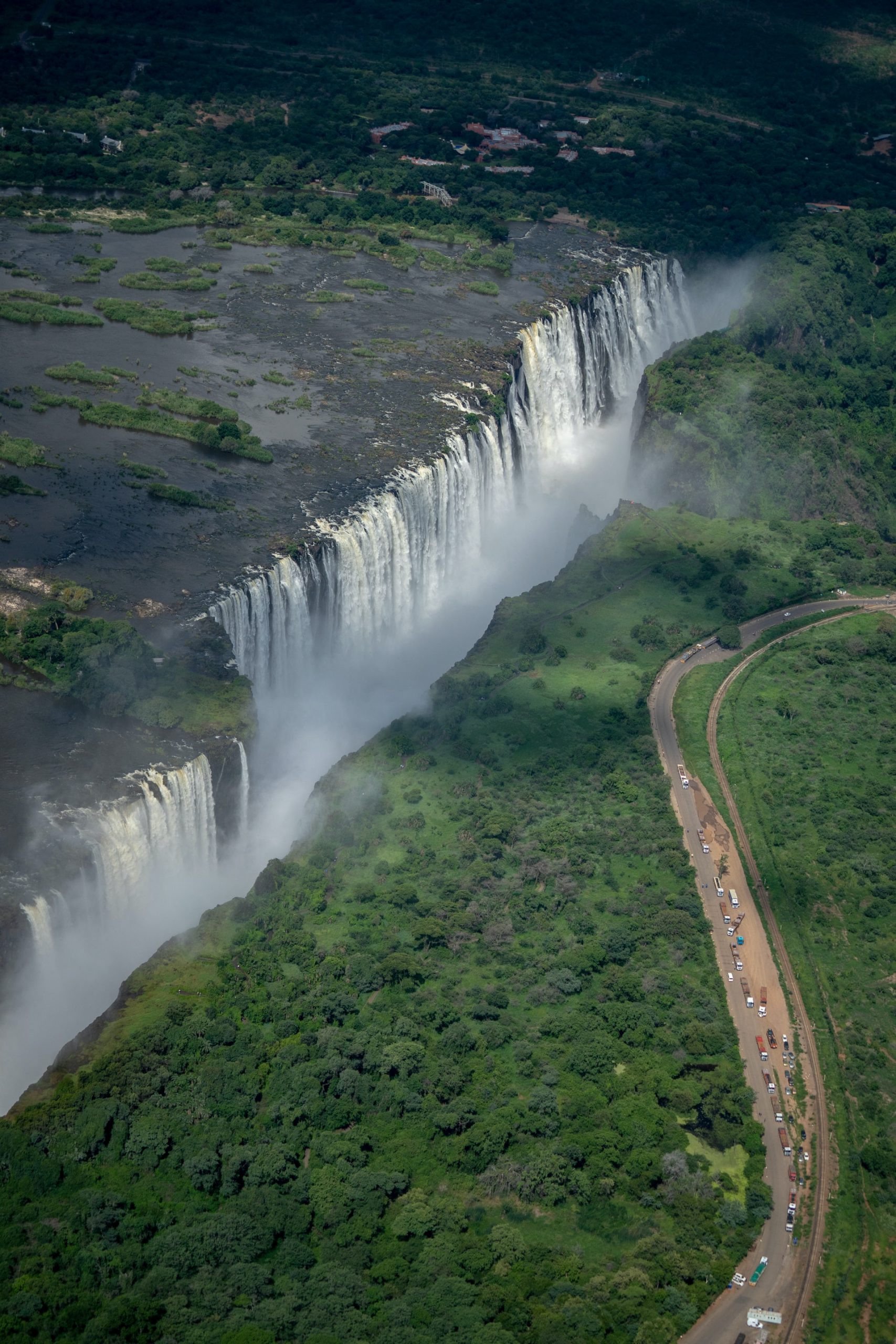
ALONG THE RIVER, villagers carve and sell wooden figurines: elephants, rhinos, lions, water buffalo. Ndelelwa always buys some, though he does not need them. I bought carvings too, and the vendor insisted on giving me a few extra.
Then Ndelelwa invited me to his village to eat nshima, a traditional thick maize porridge. We sat outside the round mud huts with grass roofs. Five children ran over to look at me with toothy smiles and a wide-eyed curiosity. As we ate from one bowl, I thanked them in their dialect, “Ndalumba.”
If the river is dammed, I wonder, what will happen to these people? How will they survive?
The last time I flipped the raft on the Zambezi, the waves were gentle. We held the perimeter rope of the capsized boat as we floated through a narrow section of canyon. Ngenda smiled as he turned the boat upright.
Dam projects are rarely stopped in industrial civilization. Save the Zambezi formed to oppose the construction of this dam. They seek help in challenging the ESIA. This dam will likely go ahead unless there is an unprecedented outcry of resistance. The Nyami Nyami protected us on the river. Perhaps his rage may once again knock down any walls placed in his path. I touch my necklace and pray for the river.
Help stop the Batoka Gorge Dam:
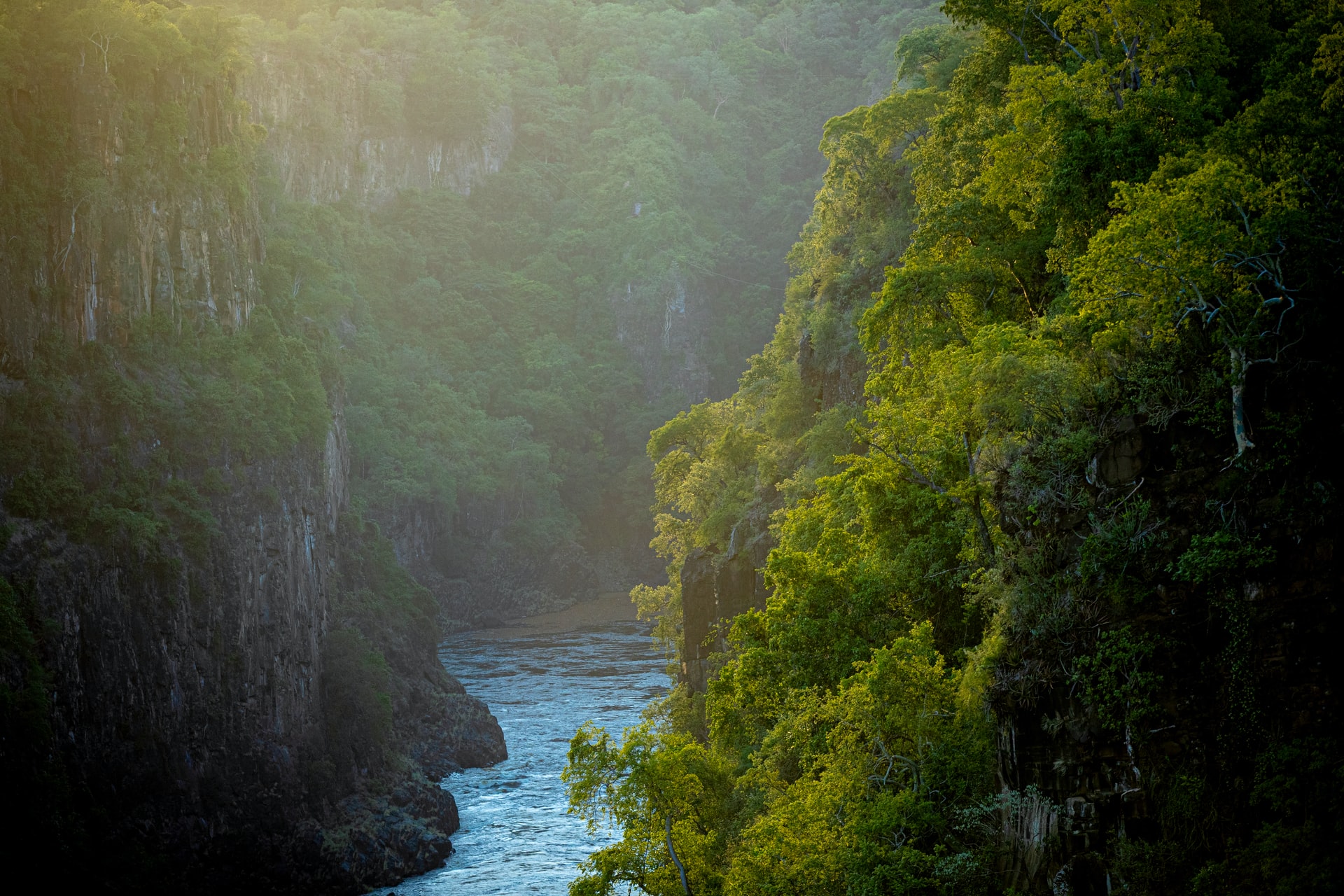 Rebecca Wildbear is a river and soul guide who helps people tune in to the mysteries that live within the Earth community, dreams, and their own wild Nature, so they may live a life of creative service. She has been a guide with Animas Valley Institute since 2006 and is the author of the forthcoming book Playing & Praying: Soul Stories to Inspire Personal & Planetary Transformation.
Rebecca Wildbear is a river and soul guide who helps people tune in to the mysteries that live within the Earth community, dreams, and their own wild Nature, so they may live a life of creative service. She has been a guide with Animas Valley Institute since 2006 and is the author of the forthcoming book Playing & Praying: Soul Stories to Inspire Personal & Planetary Transformation.
Featured image: the Batoka Gorge photograph by Prof. Davis, 1905. CC BY 4.0.
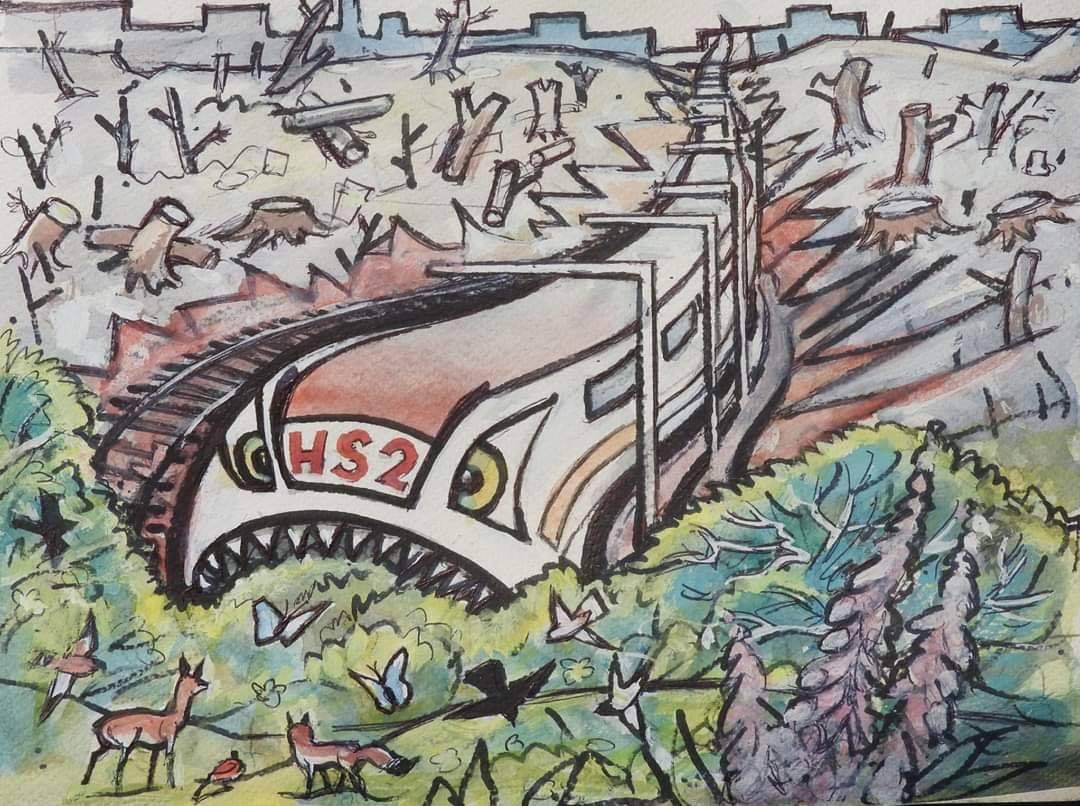
by DGR News Service | Aug 31, 2020 | Biodiversity & Habitat Destruction, Climate Change
In this writing Ben asks questions about a rail development that is destroying the natural world. He asks what it would take to stop the development and why we are not all talking about it.
Is high speed rail the pinnacle of civilisations’ insanity?
By Ben Warner
Probably not, unfortunately, but it is an excellent example. Standing in the same place for centuries should mean something. The men must have made a mistake. They have destroyed a National Asset. The National Heritage has a list of criteria for granting protected status that includes being in the same place for centuries. Why have they just demolished a possible candidate for the National Heritage List for England? The answer is, it was a tree who was razed to the ground and not a building. The tree was in the way of “progress” and those who get in the way are often crushed.<
Imagine a country so insane it would spend £100 billion during a pandemic and one of the worst recessions in human history, just to speed up a journey by 20 minutes. That’s 5 billion a minute. Imagine the same project would destroy over 700 wildlife sites including sites designated by that same culture as Sites of Special Scientific Interest (SSI) and not be carbon ‘friendly’ for at least a hundred years.
Imagine it would simultaneously threaten the water supply of its biggest city and use between 6 and 10 million liters of water during its construction. Now imagine the same project has been made obsolete by a virus that has stopped people travelling for business. Of course you do not have to imagine it. The country is the UK and it is as insane as the culture it is part of Industrial civilisation.
High Speed Rail (HS2)
The first stage of HS2 will make the rail journey from the UK’s London to Birmingham 1200 seconds quicker. That is for people who can afford the tickets, which are likely to be in the region of £50. What are people going to do with these 20 minutes? If they were commuting there is probably little they can do at work that they could not have done on the train.
The rational arguments for HS2 do not exist. There are none. But the project will continue. Why? Because it has already started, too much money has been spent and too much embarrassment will be caused, if it stopped. For a culture that prides itself on its rationality, this is baffling. Even when the evidence is so strong, it is hard to accept that our own culture is insane.
Right now there are brave people occupying woods and sleeping in tree houses attempting to slow down the HS2 project and the pointless destruction it is causing. Their efforts are courageous and valuable. Their resistance probably won’t stop HS2, but their actions will not be in vain because the morality of what they are doing is clear for all beings who care to learn about it.
What would it take to stop HS2?
The people in the camps are above ground and peaceful. But what if there was another, completely separate, group of militant underground activists using the hit and run tactics of successful resistance groups? Would sabotage stop HS2? Would sand or water or bleach in the engines of their destructive machines stop them? Would constant, relentless physical intimidation of the workers make the project impossible to complete?
What would a truly effective campaign look like and why are we not talking about it?
Ben Warner is a longtime guardian with DGR, a teacher, and an activist.
Featured image artist unknown via Stop HS2 campaign. There are suggestions of how you can help resist the destruction on their website: stophs2.org.









